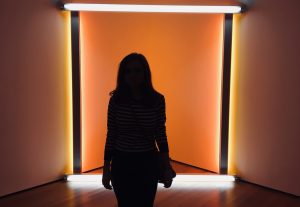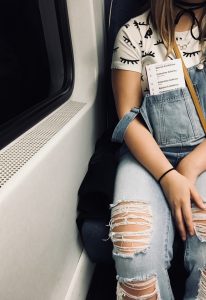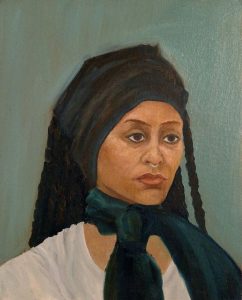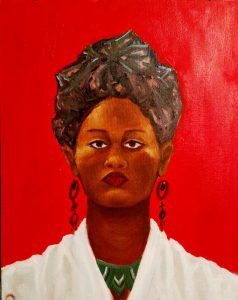Art for Women Empowerment
Curated by Samantha O’Connell ‘20
Gallery Exhibition Research Assistant and Summer Scholars Recipient
Art for Women Empowerment has a mission to support women in the art world, their art, and the subjects they paint. The all-female artists’ show will support women artists and will help bring attention to the lack of female representation in museums and galleries.
Through the many major feminist movements throughout our country including “Me Too” and “Time’s Up,” it is important to continue the fight towards equality for women. Art plays a major role in society, and I believe it is important to use art’s influence to promote the fight for feminism both inside and outside of the art world. The fight for equal rights for all women includes equal standards for women and men within the workplace and a world where women are viewed as equal to men, socially, politically and economically, and view women as more than sexual objects, but capable and powerful.
By bringing attention to the injustices and inequalities women face, the world will begin to recognize the problems and work towards change. Visual art appeals to people, which is why we go to museums; however, behind the art’s face value there is meaning, and when we take that meaning and apply it to what we see, our perspectives can be influenced, which makes art a more impactful means of promoting change. In terms of feminist art, the intentions behind the works in this exhibition, are to put emphasis on women empowerment and the inequalities women face within the art world but generally in the outside world as well. Feminist art allows viewers to reflect on its message and relate that message to the viewers’ own lives by sparking questions such as: Do I face inequality because of my gender? Do I contribute to gender inequality?
Abby Lustig
Abby Lustig is a painter from Pennsylvania. Ever since she started volunteering for a non-profit financial rehabilitation center called Homefront, her art has taken a focus toward empowerment. Abby volunteers for the art program Homefront offers, and many of the people who use the program are women. After interviewing each woman who comes in, Abby paints her portrait. “The questions I ask are about what the artist loves about herself, how she uses art to empower herself, and what aspect of the world she would like to change.” Abby uses oil paint for each painting and depending on the portrait, the creation of each one can take from 4 to 10 hours. Abby finds that each portrait turns out better when she doesn’t analyze every stroke, rather paints what she sees.

After having volunteered at Homefront for over a year now, Abby describes the people she’s worked with as “some of the most self-motivated and intelligent knowledge-seekers I have ever met. Just the other day, I had a conversation with a woman whose favorite things to talk about are quantum theory and color theory. Each visit, I grow closer to these artists and learn more about their character, not their “story.” Another woman who I am also going to paint, has daughters who have degrees in criminal justice and psychology and are extremely successful… I realized how selfless this woman is. She gave everything to her children so that they could have a better future, and she is now pursuing her education.”

Abby feels that her goal as an artist is to “remove the stigma that many people associate homelessness with and replace it with an understanding of their character and actual art.” Abby wants artists to be empowered and she wants to further her knowledge of “what great and inspiring people they are… “I intend to make the artists gain confidence, and in her mission to boost confidence and empowerment through art, Abby has built upon her interview questions in addition to asking about what the artist loves about herself. She asks questions regarding the artists’ emotions and feelings they get when they create their own work.
Alexis Trionfo
Alexis Trionfo is currently a student at Elizabethtown College with a minor in studio art. Although her traditional media was painting with oils and pastels, she found a new love for digital photography after taking a class her senior year of high school. Alexis feels that she can truly capture moments with her photography. She particularly enjoys photographing in black and white; by doing so, Alexis feels like she captures the person’s soul rather than their clothes or their particular surroundings.

Alexis’s artistic process goes beyond the technical bits of photography. She feels the closest she comes to capturing a person’s soul is when they’re smiling. As she describes, “It feels like their truest, purest forms. I like to just talk with the people that I’m photographing as normal, hoping to catch them off guard, more vulnerable and real.” It is very clear that Alexis portrays the souls of each individual she photographs whether in color or black and white.

Additionally, Alexis’s work empowers women. She feels that women, although they should be treated equally in a political and economical standpoint, women empowerment goes beyond this, because women deserve to be “viewed equally, spoken to equally, judged equally, etc.” By capturing the souls of those she photographs, Alexis unveils the way should be viewed in a society as “strong, beautiful, intelligent, creative, and independent.” She states, “Women do not need to be validated by a man before they contribute, they have earned the right to be heard and seen without justification. Empowerment has to come from that belief, and it starts with us being given a fair chance to do so.”
Courtney Agnello
CJ Agnello is a 20 year old visual and literary artist currently living in Brooklyn. She is presently pursuing her BFA at the School of Visual Arts, NYC set to graduate in 2020. Over the last two years of working towards her degree she has experimented with many different styles. While her work’s message does not come across as immediately feminist, the way she is boldly making her mark in fields that are dominated by men however is. Film, literature and painting are all artistic pursuits that she pursues and these mediums still today in 2018 are chiefly populated by men. Her work speaks for, and stands for itself when it comes to its power, feeling the presence of the women she paints and the vitality they lack or embrace. Agnello’s paintings, in this exhibition, feature paintings emphasizing the beauty of women from all different ethnicities and backgrounds, including her own self portrait. Not only does Agnello want her work to be known, but her face and named to be attached to it.

Along with portraits, Agnello’s work also includes an experimentation with body form. The colors and strokes imitate the wide range of bodily forms. By bringing them all together, she accentuates the beauty of all bodily forms. On the other hand, Agnello’s wood canvas of three figures, the question arises, who are these men? Women? This ambiguity is to emphasize the beauty of the inner person rather than their physicalities, by utilizing bright and bold palettes. When one observes these various and powerful forms, one comes to know her passion and talent for the art world.

